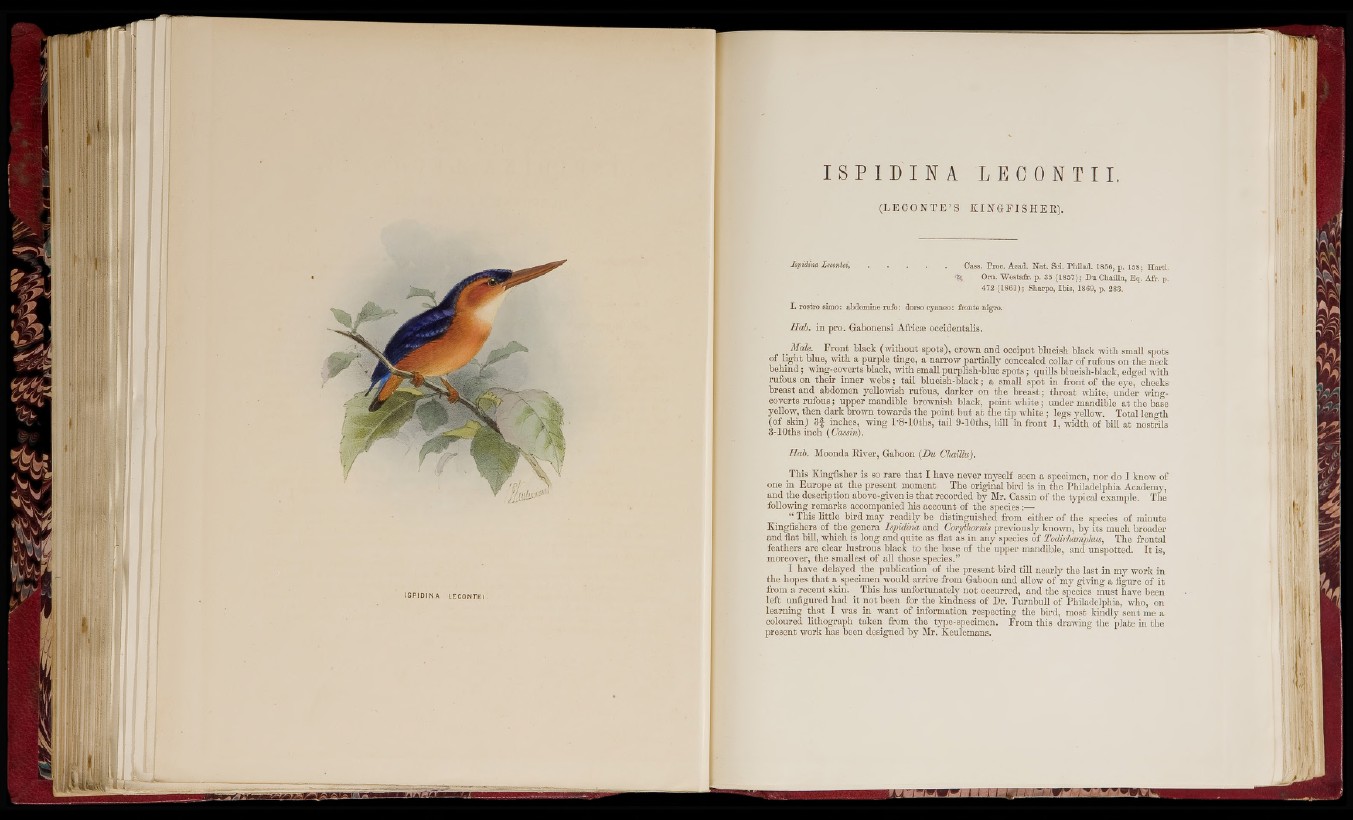
, [ | ( 1 1'
ISPIDINA LECONTEI .
I S P I D I N A L E C O N T I I ,
( L E C O N T E ’ S K I N G F I S H E R ) .
Ispidim Cass. Proc. Acad. Nat. Sci. Philad. 1856, p. 158; Harli.
\i Om. ‘Wostafr. p. 85 (1857); Du Chaillu, Eq. Afr. p.
472 (1861); Sharpe, Ibis, 1869, p. 283.
I. rostro simo: abdomine rufo: dorso cyaneo: fronte nigro.
Hab. in pro. Gabonensi Africæ occidentalis.
_ Male. F ro n t black (w ith o u t spots), crown and occiput blueish black w ith small spots
o f lig h t blue, with a purple tinge, a narrow p a rtially concealed collar o f rufous on the neck
b e h in d ; wing-coverts black, with small purplish-blue sp o ts ; quills blueish-black, edged with
rufous on th e ir in n er w e b s ; tail b lu eish -b la ck ; a small spot in fro n t o f the eye, checks
b rea s t and abdomen y e llow sh rufous, dai-ker on th e b r e a s t; th ro a t white, u n d e r wino--
coverts ru fo u s ; u pper mandible brownish black, po in t w h ite ; u nder mandible a t the base
yellow, th en dark brown towards th e p o in t b u t a t th e tip w h i t e ; legs yellow. Total leno-th
(o f sk in ) 3 | inches, win g 1-8-lOths, tail 9-lOths, bill in fro n t 1, -svidth o f bill a t nostrils
3-lOths inch (Cassin).
Hab. Moonda River, Gaboon (D u Chaillu).
This Kingfisher is so ra re th a t I have never myself seen a specimen, n or do I know of
one in Europe a t the p resent moment The original bfrd is in the Philadelphia j^urope m e reseni m e bu-d AAccaaddeemmyy,,
and the description above-given is th a t recorded by Mr. Cassin o f the typical example. The
foUoTving rem ark s accompanied his account o f th e siiecies:—
“ This little b ird may read ily be distinguished fi-om e ith e r o f the species o f minute
Kingfishers o f tbe gen era Ispidina and Corythornis previously knovm, b y its much broader
and flat bill, which is long and quite as flat as in any species o f Todirhamphus, The frontal
feathers a re clear lu stro u s black to the base o f th e ujiper mandible, and unspotted. I t is,
moreover, th e smallest o f all those species.”
I have delayed th e publication o f th e present b ird till nearly the last in my work in
the hopes th a t a specimen would arrive from Gaboon aud allow o f my giving a figure o f it
o T-onoTit Xlfis hus unfortUuately n o t occurred, and th e sjiecies m u st have been
kindnc
from a recen t skin,
left unfigured had it n o t been for the
:he specie
dness o f Dr. Turn b u ll of Philadelphia, who, on
learning tha,t 1 was in want o f information respectmg the bird, most most kindly ki
sent me a
coloured lithograph tak en from th e tyjic-specimcn. F rom th is I dra>dra>ving ving the the plate pl?
in the
p resent work has been designed b y Mr. Keulemans.
¡■1
S' iii
S' :i
! I
.■»■j
!! I
l ' I
■l’ 1